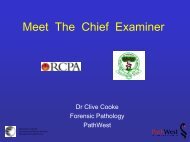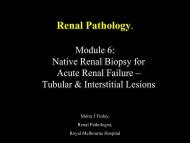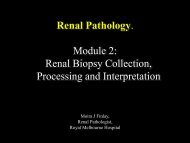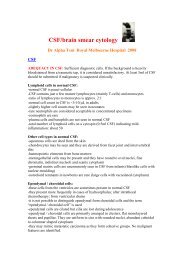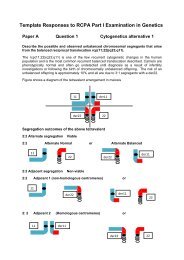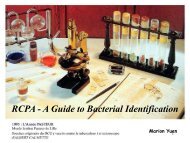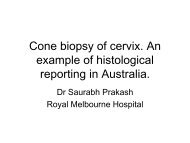Thyroid cytology - RCPA
Thyroid cytology - RCPA
Thyroid cytology - RCPA
Create successful ePaper yourself
Turn your PDF publications into a flip-book with our unique Google optimized e-Paper software.
phenomenon. Can be seen in treated Graves’, dyshormonogenetic goiter, posttherapy.<br />
4. Uniform nuclear enlargement and atypia without much variation in size and shape<br />
is more suggestive of malignancy in follicular lesions.<br />
5. Hurthle cell atypia may be more pronounced in Hashimoto’s thyroiditis than from<br />
a Hurthle cell neoplasm.<br />
6. Look very carefully for features of papillary carcinoma in any cystic lesion.<br />
Features that a cyst may be a papillary carcinoma: increased cellularity, epithelial<br />
atypia and psammoma bodies.<br />
7. Abundant colloid may be present in cystic and macrofollicular variants of<br />
papillary carcinoma. The amount of colloid present is not a reliable indicator<br />
whether the lesion is benign or malignant.<br />
8. Presence of papillary structures does not always mean papillary carcinoma. Look<br />
for the typical nuclear features.<br />
9. Presence of psammoma bodies in acellular fluid from a cystic lesion or in smears<br />
from cervical lymph nodes strongly suggests papillary carcinoma and must be<br />
excluded clinically. Cystic degeneration in a cervical lymph node in a young<br />
patient should raise suspicion of metastatic papillary carcinoma and the thyroid<br />
should be carefully examined.<br />
10. Beware significant numbers of inflammatory cells in the background which may<br />
be easily overlooked. May well be dealing with a thyroiditis. In true thyroiditis,<br />
epithelial cells are usually scanty.<br />
11. Small numbers of microfollicles are seen in a hyperplastic nodule. Abundant<br />
microfollicles strongly suggest follicular neoplasm. Always look for other features<br />
that are more typical of a hyperplastic nodule. Hence, multiple sampling of<br />
different parts of the lesion is very important.<br />
12. If both abundant colloid and marked cellularity are present, the lesion is probably<br />
a cellular hyperplastic nodule or follicular neoplasm with macrofollicular areas. If<br />
both colloid and cellularity are low, repeat FNA is recommended.




